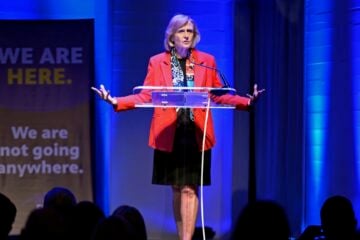Strategic advantage: women as station leaders
There are 31 women general managers in public television. When this was reported to a gathering of women at the 2002 PBS Annual Meeting, the room burst into applause.
For good reason. These are 31 highly accomplished women who shoulder not only c.e.o. responsibilities at their stations but also, in many cases, heavy national workloads as well.
Yes, we’ve come a long way since the days when there were only three or four women g.m.’s in the room at public TV conferences. When you look at it that way, the system has seen 700 percent growth in the number of female g.m.’s over the past 30-some years of its history. Impressive. On the other hand, these 31 women represent just 17 percent of the 178 g.m. positions in the system.
Why should this be a matter of concern? After all, according to the National Association of Broadcasters, “women now run 14.1 percent of the 1,693 commercial and noncommercial TV stations.” Heck, public TV is pulling up the numbers for the entire broadcast television industry! Isn’t it good enough to be “as good as” our commercial counterparts?
For an enterprise seeking to renew its relevance in local communities, the answer is clearly “no.”
The case for women executives is much the same as the argument for leaders from minority groups—also a crucial issue deserving attention in public broadcasting.
Communities need to see themselves reflected not only in the programming on public television but in its leadership as well. If our fellow community organizations are to regard our involvement as authentic and to view us as trustworthy partners, we must live up to our stated values. Promoting qualified women and people of color into leadership positions is an important and highly visible step in building system diversity, a value we all proclaim to embrace.
There are other reasons to support women’s leadership — strategic reasons stemming from changes in our environment. Organizations increasingly are working through collaboration and trust-based partnerships. Now, ask yourself who tends to have the relationship skills. At the risk of generalizing, it’s the women! Women are socialized — some would say hard-wired — to put relationships front and center. They become a strategic asset as public television redefines itself for the future.
Why are relationships becoming more important for organizations? We live in an increasingly networked world where the top-down, command-and-control management model of the industrial age is outmoded at best. The rigid hierarchies of old cannot keep up with today’s accelerated pace, greater complexity and the need for interdependent relationships to support growth. Yet this model is still popular with many men, and a few women, who find this way of leading familiar and comfortable.
Target: 30 percent
The emerging network organizational model pushes decision-making to the edges of organizations where knowledge resides, seeds growth through partnerships and requires stellar relationship skills to hold it all together. It is defined by a shift from “power over” to “power with” relationships between individuals and organizations as competition gives way to collaboration. As a result, organizations increasingly are placing a premium on the “soft skills” needed to build internal and external relationships.
This isn’t about taking over all the top jobs at stations—just 30 percent of them. Research has shown that, in any system, a group begins to have influence when it represents about a third of the membership. At 30 percent, the public TV system would begin to benefit from an improved balance in the leadership contributions of men and women. If women are to bring their formidable skills to the reinvention of public TV — skills perfectly aligned with the field’s future-forward strategy — we will need 25 more of them in the top spot, pronto.
Here we have a strategy that supports our goal of renewed relevance, reflects our diversity values and is totally within reach. So, what’s the problem? It’s not lack of chance.
So far, a lost opportunity
There have been plentiful c.e.o. job openings in recent years as a generation of system leaders begins to retire. But public TV hasn’t seized the opportunity to diversify its leadership, judging from a review of c.e.o. turnover in 2001-02.
Of the 27 men who left c.e.o. positions in the two years, only four went on to other station leader positions. Twenty-three are no longer in the system, having retired or left for other reasons. The departure of these experienced men from the candidate pool created a once-in-a-generation opportunity for new leadership talent.
So, how did stations fill their vacated chief exec positions? Mostly with other men. There were twice as many men as women among the incoming c.e.o.’s — 20 males and 11 females, with five positions open at this writing. While it appears that stations were equally willing to hire men and women who already had c.e.o. experience, they did not equally promote emerging leaders. Promotions were the major route to the top jobs, and 70 percent of them went to men (see table on previous page). The system clearly did not take advantage of the high number of retirements to advance the cause of leadership diversity by hiring women.
In years when the retirement rate is spiking, women have just held their own as a percentage of c.e.o.’s, with nine women leaving c.e.o. positions and 11 women coming in. If this hiring pattern persists, it will be a long time before women hold 30 percent of the top station jobs.
Moreover, during the past three years, the system has lost two of the three women at the head of primary stations in the top 10 markets. After the remaining woman manager, Sharon Rockefeller at WETA, you have to work your way down to market No. 32 to find the next female g.m. in a primary station.
Women c.e.o.’s have been concentrated at state networks. Nine had women in their top jobs in 2000, but with the departures of managers in Kentucky and North Dakota, the number could fall to seven.
Waiting in the wings
Are there indications of a brighter picture among emerging station leaders? I looked at the most recent federal tax Form 990s filed by the primary stations in the top 25 markets. Data were available from 21 organizations. Part V of the form requires stations to report their key employees, defined by the IRS as “any person having responsibilities or powers similar to those of officers, directors, or trustees. The term includes the chief management and administrative officials of an organization . . .”
The 21 stations reported 42 male and 30 female key employees, excluding the chief executives. Granted, this doesn’t qualify as a definitive study of the entire system, and the data aren’t as current as one would like. However, you might hazard the opinion that there is a healthy pool of female c.e.o. candidates, assuming that all career paths lead equally well to the top spot.
So, what positions did the 16 g.m.’s promoted to their new roles during 2001-2 hold beforehand? More than half were promoted from corporate management positions, including chief operating officer, chief financial officer and station manager:
How does that compare with the “key employees” reported by the 21 major-market stations mentioned above?
If the future is like the recent past, most emerging leaders will be promoted to c.e.o. from the second-tier positions of c.o.o., c.f.o. and station manager. And, if the distribution of key employees of stations in the top 25 markets is reflective of the rest of the system, as shown in the table above, it is reasonable to conclude that the c.o.o./c.f.o./station manager bench is heavily populated by men. That’s a lot of “ifs,” but assuming each of them holds true, our future will look much like our past.
Why is this happening? How did we miss the opportunity presented by the departure of 23 g.m.’s over the past two years? Clearly, we, as a system, have not yet made development of the next generation of leaders a priority. When hiring authorities lack commitment to a larger goal and access to a diverse and visible pool of qualified candidates, this outcome is stunningly predictable.
So what does this all boil down to?
- Women leaders have an important strategic role to play in the future success of public TV.
- To fulfill that role, the system needs a critical mass of women leaders to create balance in the system’s leadership, taking full advantages of the leadership contributions of men and women.
- As a generation of leaders continues to retire, we have a unique opportunity to advance more women into leadership roles.
The beauty of this situation is that we public broadcasters — and only we — have the power to turn this situation around. We don’t need a major research study or a Ford Foundation grant to do what needs to be done. Here are some ideas to start the conversation:
- Make the development of the next generation of leaders a systemwide priority and recognize those stations that excel in this important strategic activity.
- Create awareness across the system and particularly in boards of directors that the system needs to develop and promote women and people of color into leadership positions.
- Spread the practice of succession planning at stations.
- Present the g.m. position as a worthy and rewarding role to attract the best talent from throughout the system and elsewhere.
- Identify and eliminate the barriers to advancement.
- Present leadership development opportunities at all system meetings.
- Create and sustain leadership development programs.
A small but important beginning is an online survey I’ve posted, asking women in public TV and radio about their professional growth needs. If you’d like to participate in the survey, please click here.
Another resource available to stations is The Main Event, an annual leadership development teleconference that will take place April 10. Many public television people have found this an engaging event for staff and community members.
Most of these progressive steps require more resolve than resources. And that resolve must come from the current leadership of the industry — local and national, men and women. It’s simply a matter of making it a priority, not just for this budget cycle, but for the future of the system.
Cindy Browne is the president of Leader Evolution, LLC, based in White Bear Lake, Minn. She works with nonprofit organizations on projects involving partnering, change leadership and organizational renewal. Browne has more than 20 years of management experience in public broadcasting and volunteers her time in support of women’s leadership in the field.






